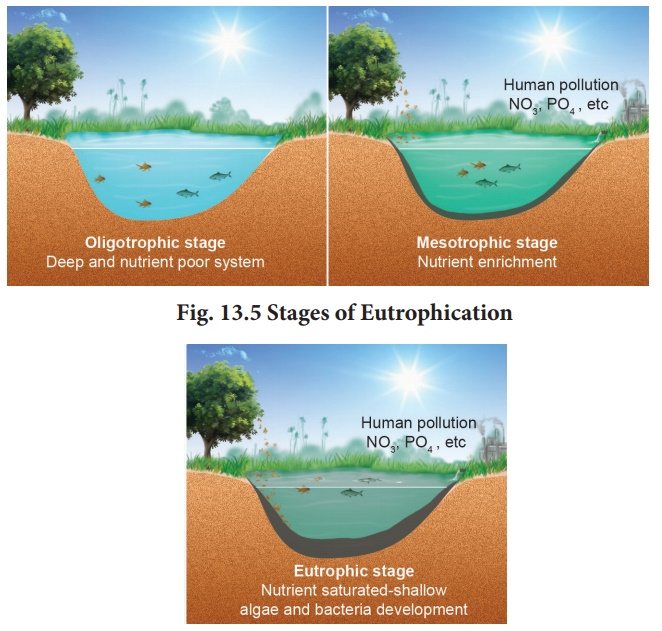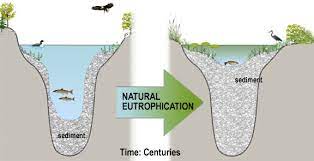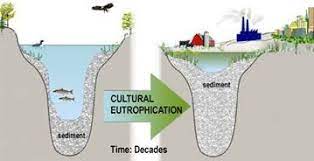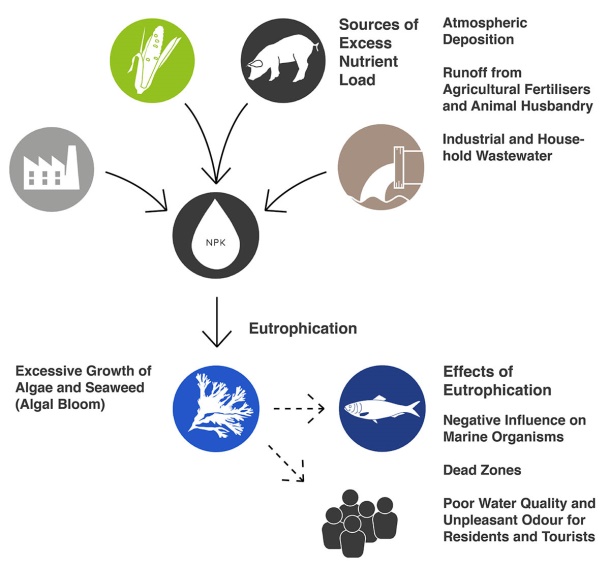CSS Solved Environmental Science Past Papers | Define Eutrophication. Explain the difference between natural and cultural eutrophication. Discuss the methods of combating eutrophication
The following question of Environmental Science is attempted on the same pattern, taught by Sir to his students, scoring the highest marks in compulsory subjects for years. This solved past paper question is uploaded to help aspirants understand how to crack a topic or question, how to write relevantly, what coherence is, and how to include and connect ideas, opinions, and suggestions to score the maximum.

Question Breakdown
This question revolves around three components that are defining eutrophication, identifying the various causes, the difference between natural and cultural eutrophication, and the methods of combating eutrophication. Make headings and subheadings to stand your paper out from other aspirants. You can strengthen your arguments by providing valid case studies from Pakistan and the international community. Make a comprehensive outline that must include all the solid points of your answer. This will not only give you the right direction to tackle the question but also make it easier for the examiner to reward greater marks to you.
Outline
1- Introduction
2- Defining the concept of “Eutrophication”
- ✓Explanation of stages of eutrophication
- ✓Possible causes of eutrophication
3- Natural eutrophication vs Cultural eutrophication
- ✓Natural eutrophication
- ✓Cultural eutrophication
4- Impacts of eutrophication on the ecosystem
- ✓Ecological impacts
- ✓Economic impacts
- ✓Human health impacts
5- Prevention and control of eutrophication
- ✓ Biological methods
- Bioaugmentation and Biomanipulation
- Oyster reef restoration
- ✓ Chemical Methods
- Carbon-based compounds
- Nitrogen reducing agents
- ✓ Physical Methods
- Nutrient reduction technologies
- Dredging
6- Case studies
- ✓Manchar lake Pakistan
- ✓The Baltic Sea , Europe
7- Conclusion

Answer to the Question
Introduction
Eutrophication is a process where bodies of water become enriched with excessive amounts of nutrients, mainly nitrogen and phosphorus, leading to the growth of plants and algae. This can result in a decrease in oxygen levels, which can have harmful effects on aquatic life and cause death. Eutrophication can occur naturally, but it can also be caused by human activities such as agriculture, industrial processes, and sewage treatment. Cultural eutrophication happens faster and causes more severe problems than natural eutrophication, which occurs over a longer period. There are various ways (Chemical, Biological, and Physical) to combat eutrophication, including better land use management to reduce nutrient inputs into bodies of water, improving wastewater treatment systems, and raising public awareness of the issue. Chemical treatments and dredging can also be used to remove excess nutrients and restore the aquatic ecosystem’s balance. Addressing eutrophication is crucial to safeguarding the health of aquatic environments and the organisms that rely on them.
Defining the concept of “Eutrophication”
Eutrophication is the process in which excessive nutrients, particularly nitrogen, and phosphorus, are introduced into aquatic ecosystems, stimulating the growth of algae and other aquatic plants. This process can lead to the formation of dense vegetation, harmful algal blooms, and the depletion of oxygen levels in the water. Eutrophication can have significant environmental, economic, and social impacts. To prevent eutrophication, it is crucial to reduce the number of nutrients entering waterways and promote the responsible use of fertilizers and nutrient-rich products.
“The European Environment Agency (EEA) reported in 2019 that eutrophication is one of the main environmental challenges facing Europe’s freshwater systems, with over 50% of the continent’s lakes and rivers affected by nutrient pollution”.
- ✓ Explanation of stages of eutrophication
There are several stages of eutrophication, beginning with the oligotrophic stage, where nutrient concentrations are low, and the water is clear and supports limited aquatic plant growth. As nutrient concentrations increase, the water enters the mesotrophic stage, where there is a moderate amount of algae and aquatic plant growth, and dissolved oxygen levels may decrease. In the eutrophic stage, the water body supports a large number of algae and aquatic plant growth, leading to dense mats or blooms on the surface of the water, murky water, and decreased dissolved oxygen levels. In severe cases, the eutrophic stage can progress to the hypereutrophic stage, where there is an excessive amount of algae and aquatic plant growth, green, brown, or red water, and a foul odor. Dissolved oxygen levels are significantly decreased, leading to the death of many aquatic organisms.

Understanding the different stages of eutrophication is important for managing and preventing its negative effects on aquatic ecosystems
- ✓Possible causes of eutrophication
Eutrophication has both natural and anthropogenic causes. Natural causes include weathering of rocks and minerals, and soil erosion and runoff, which carry nutrients from the land into the water. Anthropogenic causes of eutrophication include agricultural practices, urbanization and industrialization, and the discharge of sewage and wastewater which increase the number of impervious surfaces and discharge of pollutants into the water, which contain high levels of nutrients. These causes contribute to the harmful effects of eutrophication, such as the depletion of oxygen in the water, fish kills, and loss of biodiversity.
Natural eutrophication vs Cultural eutrophication
Eutrophication can occur naturally over extended periods of time, but it can also be accelerated by human activities. It’s important to differentiate between natural eutrophication and cultural eutrophication, as both entail the accumulation of nutrients in water bodies but arise from distinct causes and have different effects. Natural eutrophication refers to the gradual nutrient enrichment of water bodies through natural processes, while cultural eutrophication arises from human actions that introduce excessive amounts of nutrients.
- ✓Natural eutrophication
Natural eutrophication is a process that occurs naturally and can have positive and negative effects on aquatic ecosystems. Natural eutrophication happens when a body of water becomes more nutrient-rich over time due to natural causes, like runoff from surrounding land, atmospheric deposition, and decomposition of plant matter. This process takes centuries for its manifestation; however, human activities can expedite this process, leading to more severe environmental issues. This process can lead to the growth of aquatic plants and algae, causing several environmental problems like decreased oxygen levels, altered water chemistry, and reduced biodiversity.

- ✓Cultural eutrophication
Cultural eutrophication is the overgrowth of algae and other aquatic plants caused by the introduction of excess nutrients, primarily nitrogen and phosphorus, into a water body. This is primarily caused by human activities such as agriculture, wastewater discharge, industrial processes, and land use changes. This process takes only few decades for its manifestation. When these excess nutrients enter a water body, they stimulate the growth of algae and plants, which can lead to oxygen depletion, fish kills, and unsightly water conditions.

Impacts of eutrophication on ecosystem
Eutrophication has lasting and far-reaching consequences for ecosystems and human communities. Eutrophication has a range of positive and negative impacts on ecosystems, biodiversities and the economics of the human community. Some of its impacts are discussed below:
- ✓Ecological impacts
Eutrophication is a complex process that can have severe ecological impacts on aquatic and terrestrial ecosystems. Eutrophication can cause algal blooms (excessive growth of algae), which block sunlight and deplete oxygen levels in the water, creating “dead zones” where aquatic life cannot survive. The decomposition of algae can further reduce oxygen levels, leading to the suffocation of fish and other animals. The loss of these animals can have a cascading effect on the entire food chain, disrupting the balance of the ecosystem.
- ✓Economic impacts
Eutrophication can have significant economic impacts on local communities and industries. Unsightly and odorous algae blooms can deter tourists, reducing tourism revenue, while lower property values may occur due to unpleasant sights and smells. Eutrophication can also increase water treatment costs and harm commercial fishing industries, leading to a spike in seafood prices for customers. For developing countries like Pakistan these impacts can be overlapped with other domains of development.
- ✓Human health impacts
Eutrophication can create several negative impacts on human health. Excess nutrients, mainly nitrogen, and phosphorus, can cause harmful toxins to enter the drinking water supply, posing a severe risk to human health. In addition, exposure to these toxins can cause skin rashes, respiratory irritation, and other health problems for people engaging in recreational activities. It also leads to the accumulation of harmful toxins in fish and shellfish, which, if consumed, can cause shellfish poisoning. Furthermore, eutrophication can release greenhouse gases that contribute to climate change, leading to respiratory illness and cardiovascular disease.

Prevention and control of eutrophication
Eutrophication has the potential to destroy different components of a community. Therefore it is necessary to take measures to prevent and control eutrophication in order to make a healthy environment. Some of the methods are discussed below to tackle the formation and growth of eutrophication on a larger scale.
- ✓Biological methods
There are several biological methods that can be used to prevent eutrophication by reducing the number of nutrients available to algae and other aquatic plants, improving water quality, and restoring natural ecosystems. These methods offer a sustainable and cost-effective approach to addressing environmental issues while promoting biodiversity and ecosystem health. Some commonly used methods are given below:
- Bioaugmentation and Biomanipulation
Both Bioaugmentation and Biomanipulation can be effective strategies for preventing eutrophication, but they require careful planning and monitoring to ensure that they are implemented effectively and that they do not have unintended negative impacts on the ecosystem. Bioaugmentation involves adding microorganisms such as bacteria, fungi, algae, and aquatic plants to the water, enhancing its natural ability to remove excess nutrients. These microorganisms break down organic matter and consume excess nutrients, improving the natural processes that prevent eutrophication. Biomanipulation, on the other hand, involves manipulating the species composition of an aquatic ecosystem to decrease nutrient levels. This can include introducing or increasing populations of certain fish species that consume excess algae and reducing populations of other species that contribute to nutrient inputs, ultimately preventing eutrophication by altering the ecosystem’s species composition.
- Oyster reef restoration
One effective method for preventing eutrophication is through oyster reef restoration. Oyster reefs act as natural filters, removing nitrogen and phosphorus from the water while also providing habitats for marine species, which enhances biodiversity and ecosystem health. Oyster reef restoration involves the placement of oyster shells or other materials in areas where populations have declined. This provides a substrate for larvae to settle and grow, ultimately facilitating the re-establishment of oyster populations. Therefore, oyster reef restoration is a promising strategy for preventing eutrophication and promoting ecosystem health in marine environments.
- ✓Chemical Methods
Chemical methods can be used to prevent or mitigate eutrophication, but they are typically not a first choice due to their potential environmental impact. However, some of the eco-friendly methods are enlisted below:
- Carbon-based compounds
The use of carbon-based compounds through a process called carbon sequestration is an effective strategy for mitigating the impacts of nutrient pollution and promoting a healthy ecosystem. Carbon-based compounds can be used for the prevention of eutrophication through a process called carbon sequestration. This involves capturing carbon dioxide from the atmosphere and storing it in a stable form, such as in soil, plant biomass, or aquatic sediments. Carbon-based compounds such as dissolved organic carbon (DOC) can help to reduce eutrophication by providing a food source for microbes that can break down excess nutrients. Similarly, carbon-based compounds such as biochar, compost, and manure can be added to soil to increase its carbon content, which can help to reduce nutrient runoff and prevent the eutrophication of nearby waterways.
- Nitrogen reducing agents
To prevent eutrophication, nitrogen-reducing agents can be used, including biological agents such as certain bacteria, such as Nitrosomonas and Nitrobacter, which can convert ammonia to nitrite and nitrite to nitrate, respectively. These bacteria can be added to water treatment systems to help reduce nitrogen levels. Chemical agents like aluminum sulfate and calcium chloride involve a process called coagulation and can be effective in removing nitrogen from the water. Vegetative buffers and constructed wetlands are also good available options for the prevention of eutrophication. A combination of these methods may be most effective in reducing nitrogen levels and preventing eutrophication.
- ✓Physical Methods
There are several physical methods that can be used for the prevention of eutrophication:
- Nutrient reduction technologies
Nutrient reduction technologies are methods used to reduce nutrient levels in water bodies to prevent eutrophication. These include bioreactors, constructed wetlands, sedimentation tanks, nutrient scrubbers, and ozone treatment. Bioreactors use denitrifying bacteria to convert nitrate into nitrogen gas, while constructed wetlands and sedimentation tanks remove nutrients through vegetation and sediment settling. Nutrient scrubbers use artificial light and algae to consume nutrients, while ozone treatment breaks down organic matter. These technologies can be used individually or in combination to effectively manage nutrient levels and improve water quality.
- Dredging
Dredging is a process of removing sediment from water bodies to increase depth, remove pollutants, or create new land. It can be used to prevent or mitigate eutrophication. Dredging can be done using a variety of methods, including mechanical dredging, hydraulic dredging, and suction dredging. Mechanical dredging involves using excavators or bulldozers to physically remove the sediment, while hydraulic dredging uses high-pressure water jets to loosen the sediment and then pump it out. Suction dredging uses a vacuum-like mechanism to remove sediment. However, dredging is not always the most effective or appropriate solution for eutrophication prevention, and its use should be based on careful evaluation of the circumstances and alternatives available.
Case studies
“Smith, V.H. (2003). Eutrophication of freshwater and coastal marine ecosystems: a global problem. Environmental Science & Pollution Research, 10(2), 126-139. This review article provides an overview of the causes, impacts, and management of eutrophication in both freshwater and coastal marine ecosystem’’.
- ✓Manchar lake Pakistan
Manchar Lake in Pakistan has been affected by eutrophication for several decades. The primary cause of eutrophication is the discharge of untreated industrial and agricultural wastewater into the lake, which leads to excessive growth of algae and reduced water quality. This put negative impacts on aquatic life and human health and has affected the livelihoods of local fishermen and agricultural productivity.
- ✓The Baltic Sea, Europe
Eutrophication in the Baltic Sea is a major environmental issue that has been affecting the region for several decades. The Baltic Sea is particularly vulnerable to eutrophication due to its shallow and relatively closed nature, which means that it has a limited ability to flush out excess nutrients. The main sources of nutrient pollution in the region include agricultural runoff, sewage discharges, and atmospheric deposition.
Conclusion
In summary, eutrophication is a significant environmental issue that can have severe impacts on aquatic ecosystems. While natural eutrophication is a slow process that occurs over long periods, cultural eutrophication is caused by human activities and can have a rapid and significant impact on water quality. However, there are several methods available to combat eutrophication, and with continued efforts to reduce nutrient inputs and improve sewage treatment, we can help to protect our waterways and the wildlife that rely on them.
CSS Solved Past Papers’ Essays
Looking for the last ten years of CSS and PMS Solved Essays and want to know how Sir Kazim’s students write and score the highest marks in the essays’ papers? Then, click on the CSS Solved Essays to start reading them.
CSS Solved Essays

CSS Solved General Science & Ability Past Papers
Want to read the last ten years’ General Science & Ability Solved Past Papers to learn how to attempt them and to score high? Let’s click on the link below to read them all freely. All past papers have been solved by Miss Iqra Ali & Dr Nishat Baloch, Pakistan’s top CSS GSA coach having the highest score of their students.
General Science & Ability Solved Past Papers
CSS Solved Pakistan Affairs Past Papers
Want to read CSS Pakistan Affairs Solved Past Papers and learn how to attempt them to score high? Let’s click on the link below to read them all freely. All past papers’ questions have been attempted by Sir Kazim’s students, who scored the highest in the subject.
CSS Solved Pakistan Affairs
CSS Solved International Relations’ Past Papers
Have you opted for International Relations in the CSS examination and want to score above 150? Then, click on the CSS Solved International Relations’ Past Papers by Miss Abeera Fatima, the top IR scorer and the best IR coach in Pakistan.
CSS Solved International Relations Past Papers
Articles Might Interest You!
The following are some of the most important articles for CSS and PMS aspirants. Click on any to start reading.












